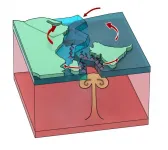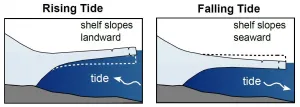(Press-News.org) What happens when climate change affects the abundance and distribution of fish? Fishers and fishing communities in the Northeast United States have adapted to those changes in three specific ways, according to new research published in Frontiers in Marine Science.
Becca Selden, Wellesley College assistant professor of biological sciences, and a team of colleagues examined how fishing communities have responded to documented shifts in the location of fluke and of red and silver hake. The team found that fishers made three distinct changes to their approaches: following the fish to a new location; fishing for a different kind of fish; and bringing their catch to shore at another port of landing.
Selden began this research as a postdoctoral scholar at Rutgers University in New Jersey with Eva Papaioannou, now a scientist at GEOMAR. They combined quantitative data on fish availability from surveys conducted by the National Marine Fisheries Service at the Northeast Fisheries Science Center and a unique geographic information system database from fishing trip records developed for this project. The researchers then interviewed fishers in 10 ports from North Carolina to Maine.
They explored three dominant strategies, and found that fishers throughout the Northeast were more likely to shift their target species. In interviews, the researchers learned that targeting a mix of species is a critical option for adaptation. Doing so can be complicated, however, because in many cases regulations and markets (or the lack of a market) constrain fishers' ability to take advantage of a changing mix of species in fishing grounds. For example, in Point Pleasant, N.J., fishers can't capitalize on an increase in dogfish in the region because of strict conservation measures that have been in place since 1988, when the species was declared over-fished, and the resulting absence of a market for those fish.
"Most communities tend to fish where they have fished for generations, and therefore, for any fishery management plan to be more climate-ready in the future, it needs to take that into account," Selden said. "They're less likely to move where they fish, more likely to switch what they fish, but only if they can, and regulations play a big role in that being successful."
The researchers also learned about a previously undescribed strategy in which fishers change where they bring the fish ashore to sell. This is particularly common for vessels coming from northern fishing communities that sell fluke in Beaufort, N.C. "Had we not combined the quantitative data with the in-depth interviews with community members, we would have totally missed the phenomenon we saw come to light in Beaufort," Papaioannou said. "It made for such a powerful way of analyzing the data, so that we were really using it to influence the questions we would ask in each interview, and the interviews would drive what we would examine in the quantitative data. I think that approach really made for a much more complete look at the impact of changes in species distribution and fishers' adaptations."
Of the fishing communities they studied, only the one in Beaufort used the tactic of following fish to new grounds. Unlike communities in the north, fishers in Beaufort have targeted fluke heavily in the past, and because the port is on the southern edge of the range for this species they are more vulnerable as the species shifts north. "Beaufort fishers have gone to tremendous lengths to keep fishing fluke," Selden said, "and following fish to new grounds brings its own constraints and concerns." These include the cost of increased fuel use, safety issues due to vessel size, and the local environmental knowledge needed to fish successfully in new locations.
All of these responses are intertwined, Selden said, so as we learn more about the effects of climate change on the future of fishing, understanding, predicting, and planning for any one of them will require examining all three together.
The researchers focused on the Northeast because it has been a hotspot of recent ocean warming, especially in the Gulf of Maine, and in some ways it is a harbinger of what other areas might be experiencing soon, Selden said. Along the East Coast, she said, "you have species that have these state-by-state regulations, you're passing through different jurisdictions and three different fisheries management councils, and species are crossing boundaries all over the place. This all has an impact on fishers, their behavior, and their communities."
Selden plans to continue this work on the West Coast--where there are only three states and one fishery management council--to compare how stable their fishing grounds are and how much fishers are switching species versus shifting where they fish.
"Fisheries are really on the frontline of climate impacts," Selden said. "It's really a bipartisan issue, and there are stakeholders across party lines. That was my motivation to focus on how communities are adapting, how they've adapted to past change. We need to be able to understand how they might adapt to future change and potentially how we would need to change management to facilitate some of the adaptations that they are already demonstrating."
The team is building a website that fishers and communities can use to see some of these patterns and learn more about what their counterparts elsewhere are doing about them. Community leaders and fishery management officials could also use the information to promote a broader understanding of the issues and potentially prioritize fishery development projects or plan for where a species will go next.
INFORMATION:
July 8, 2021 - Until relatively recently, opioids were a mainstay of treatment for pain following total hip or knee replacement. Today, a growing body of evidence supports the use of multimodal analgesia - combinations of different techniques and medications to optimize pain management while reducing the use and risks of opioids, according to a paper in The Journal of Bone & Joint Surgery. The journal is published in the Lippincott portfolio in partnership with Wolters Kluwer.
"Multimodal analgesia has become the standard of care for total joint arthroplasty as it provides superior analgesia with fewer side effects than opioid-only protocols," write Javad Parvizi, ...
Augmented reality (AR) is poised to revolutionise the way people complete essential everyday tasks, yet older adults - who have much to gain from the technology - will be excluded from using it unless more thought goes into designing software that makes sense to them.
The danger of older adults falling through the gaps has been highlighted by research carried out by scientists at the UK's University of Bath and the Bath-based charity Designability. A Paper describing their work has received an honourable mention at this year's Human Computer Interaction Conference (CHI2021) - the world's largest conference of its kind.
The study concludes that adults aged 50+ are more likely to be successful at completing AR-prompted tasks (such as 'pick up the cube' followed by 'move the cube to the blue ...
Skoltech biologists and their colleagues from Koltzov Institute of Developmental Biology, Russia, and the Chemistry Department of Taras Shevchenko University in Ukraine have discovered fairly unlikely drug candidates for treating liver fibrosis and other pathologies -- among pest control chemicals. In addition, the team looked at modifications of the medication called hymecromone, deeming them promising for anti-fibrotic drugs, too. Published in Glycobiology, the study also sheds light on the possible mechanism of action of the investigated compounds, all of which inhibit the synthesis of hyaluronic acid.
Hyaluronic acid is an important biological compound that is a key component ...
The plates of the Earth's crust perform complicated movements that can be attributed to quite simple mechanisms. That is the short version of the explanation of a rift that began to tear the world apart over a length of several thousand kilometers 105 million years ago. The scientific explanation appears today in the journal Nature Geoscience.
According to the paper, a super volcano split the Earth's crust over a length of 7,500 kilometers, pushing the Indian Plate away from the African Plate. The cause was a "plume" in the Earth's mantle, i.e. a surge of hot material that wells upwards like an atomic mushroom cloud in super slow motion. It has long been known that the ...
WASHINGTON--Tidal stresses may be causing constant icequakes on Saturn's sixth largest moon Enceladus, a world of interest in the search for life beyond Earth, according to a new study. A better understanding of seismic activity could reveal what's under the moon's icy crust and provide clues to the habitability of its ocean.
Enceladus is about 500 kilometers in diameter and almost entirely covered in ice. The moon is nearly 10 times as far away from the Sun as Earth and its bright surface reflects most sunlight, making it very cold, yet researchers have long ...
Newborn infants and babies aged up to three months should be stimulated to manipulate objects and observe adults performing everyday tasks. This incentive helps their social, motor and cognitive development, researchers note in an article published in the May 2021 issue of the journal Infant Behavior & Development.
According to the authors, from the earliest age babies watch adults carrying out activities such as handling utensils and putting them away in drawers or closets. They should themselves have frequent contact with objects to develop the ability to hold things and reach out for them. Through social interaction, ...
Diabetes is the leading cause of kidney failure in the United States, but identifying type 1 or type 2 diabetes patients at high risk for progressive kidney disease has never had a sure science behind it.
Historically, assessing kidney function meant looking at estimated glomerular filtration rate, a calculation that determines how well blood is filtered by the kidneys, and urine albumin excretion, a urine test to detect the amount of the protein albumin, which is filtered by the kidneys. However, both tests have limited predictive power in early stage diabetes when kidney function is normal.
The therapeutic approach to both type 1 and type 2 diabetic ...
A multi-institutional study has discovered spontaneous mutations in RNF2 (RING2) gene as the underlying cause of a novel neurological disorder. This Undiagnosed Diseases Network (UDN) study was led by Dr. Shinya Yamamoto, investigator at the Jan and Dan Duncan Neurological Research Institute (NRI) at Texas Children's Hospital and assistant professor at Baylor College of Medicine, and Dr. Vandana Shashi at Duke University Medical Center. Using a combination of comprehensive clinical tests, trio genome sequencing and functional studies in the fruit flies, and global gene matchmaking efforts, the teams found ...
Amsterdam, July 8, 2021 - While the literature on the digital divide has widely addressed the digital gender gap, its potential implications for electronic government (e-government) / digital government research and practice have hardly been studied. In this Special Issue of Information Polity experts characterize the current state of understanding of the issues surrounding digital government and gender and present an agenda for future research.
Gender is a neglected topic in the literature on digital government. According to the International Telecommunications Union, women are lagging behind men in making ...
demic have already had a dramatic impact on the prevailing oral health care model and will continue to do so. The paper "Advocacy for a Digital Oral Health That Leaves No One Behind," published in the JDR Clinical & Translational Research (JDR CTR), promotes the use of digital tools to offer opportunities to improve healthy behavior, lower risk factors common to oral diseases and other noncommunicable diseases and contribute to reducing oral health inequalities.
To mitigate the impact of the COVID-19 pandemic lockdowns, systems were quickly put in place in most countries to respond to dental emergencies, ...





